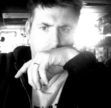Kevin Lucia's Blog, page 45
July 10, 2012
On Transcending the Genre; Lots of "Real Life Stuff In Horror"
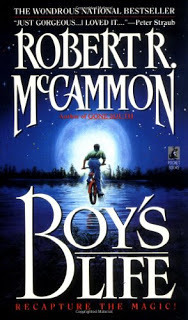 Yes, I know. This has been blogged about by other writers much better than I. And no, I probably don't have anything new to add. Like everything else here, today's blog was generated from stuff in my life, and the connections I made between that and writing.
Yes, I know. This has been blogged about by other writers much better than I. And no, I probably don't have anything new to add. Like everything else here, today's blog was generated from stuff in my life, and the connections I made between that and writing.Also, I'm framing this thought not only as a developing writer, but mostly as a reader. Though it's what I'm reaching for in my own pitiful scribblings, it's what REALLY drives me as a reader. These are the kinds of stories I love. That's probably the only authority I have, here. Not in all the awesome writing I've done to back this up, but all the novels and writers I love.
Seems like, to me - in my reading experience - there are a couple of ways to transcend the genre. First of all: What does that even mean? That gets tossed around SO much in reviews (that, and calling a writer's prose lyrical. Not sure if reviewers know what THAT means, either), and I wonder if we really take the time to think about what that means. Let's do a quick breakdown:
transcend: To pass beyond the limits of; To be greater than, as in intensity or power; surpass; exist above and independent of
So, for a work to transcend its genre, something in it must pass beyond the limits of that genre. Be greater than it. Exist above and independently of it. What does that mean, for horror? That something in it - either style, substance, plot, characterization - lifts that work above the horror genre, offering itself to wider appeal.
Now, to clarify: there's nothing wrong with something that works solidly within its genre. No shame there. A recent example would be The Wicked, by James Newman. It's a straight-up, evil demon threatening small town, with plenty of gory, fast action. But it's very well done.
But, transcending the genre. How? Again, this is based on what I've read, certainly not what I've accomplished:
1. style: that's probably the easiest way to transcend genre, but still work within the genre. The names I immediately think of are: Charles L. Grant, Norman Prentiss, T. M. Wright, Ramsey Campbell, Rob Dunbar, Ray Bradbury, T. L. Hines, Rio Youers, Ron Malfi....the list could go on. And I could wax poetic about this forever, but I won't. Basically, in these writers' works, you find stylistic elements in prose and structure (lyricism, word choice, sentence structure, balance, flow, taut atmosphere, vivid - but not purple - description, nonlinear storytelling) that elevate something that could be beer or liquor or champagne into fine, aged wine. Now, plenty of these writers have penned straight out horror stories. But their craft transcends the norm of the genre, and may potentially attract readers based on the value of their words, alone.
And again, keep in mind: these are all my opinions. Worth about as much as that truck of salt, over there. Maybe not even that.
2. characterization: a great character - often series characters - transcend genre boundaries. I've said it before and I'll say it again, F. Paul Wilson stumbled onto something brilliant with Repairman Jack. As the series draws to a close and the end of its Cosmic War, as it gets darker: definitely shades of horror. But Jack faces so many different types of situations, HE transcends horror. The Tomb, Haunted Air, maybe even Gateways and Infernal could be considered horror. But Jack's a man of many a talents, so he transcends genre.
And - hate 'em or love 'em - Stephen King and especially Dean Koontz regularly transcend their genre. Why do you think SO many people say: "I don't really read horror, but I read Steve King and Dean Koontz"? Because there's something in the characters that LOTS of people connect with. Call it selling out, fine. But isn't that transcending the genre?
In his best novels, Steve King paints intimate, deep portraits. Even if it's just the mailman who's gonna get killed on the next page. Again, say BOO! to all the haters, but I adore The Stand. It's what made me love Steve King. The characters in that behemoth of a novel are so painfully real, so vibrant.
And, Dean - well, his greatest strength is what he gets slammed for so much. (Again, my opinion only, but another good-natured BOO! to all the haters). Why is Dean Koontz SO massively popular? You could say: "Oh, cause he's a sellout and writes wimpy happy-slappy, goody-two-shoes fiction that always ends well for all the idiot masses."
OR....
Maybe his ideals and values - and his belief of what a character or HERO SHOULD BE is a lot more widespread and popular - than his critics want to think. I remember very clearly, at Borderlands Press Writers Bootcamp a few years ago, F. Paul Wilson adamantly arguing for SOME sort of positive closure in the end, because most people, in his opinion, still root for the "good guy" and want the good guys - and gals - to win.
Are Dean Koontz's characters very idealistic - very good, and very bad? Yes. Are his child characters very, very good? Almost too good? Yes. But it would appear that most of us still want that. So he's transcended genre, also, so much so he "stopped" being a "horror" writer a long time ago.
3. substance/plot to genre ratio: what the heck does that mean? Basically, what's most important in this story? The genre elements, or the plot's substance? The plot's "LIFE STUFF" (the core of this blog, finally). A really good example (not out yet; yes, be jealous of the reviewer who gets advance copies) is Ron Malfi's upcoming The Narrows. It's as much about a small, dying town - and the people living in it - as it is about the monster threatening it.
Robert Dunbar's best two works, The Pines and The Shore, deal with the mythological "Jersey Devil." So, yeah - plenty of horror and gruesome, nasty killing. But not only is the prose vivid, descriptive, and sophisticated, demanding something from the reader...the stories are about people. Lost, lonely people. Folks looking - maybe even in vain - for something better.
An EXCELLENT example is Ramsey Campbell's Obsession , recently re-printed by Samhain Horror. Yes, it is horror - definitely some supernatural elements there. But they're so understated, so subtle, the characters rule the day, here. It's more about them and their lives than anything else.
What I love about Robert McCammon's novels - the ones I've read so far - are the journeys he takes us on, as readers. Yes, he writers horror - but, like life, his novels are journeys. They're about people. Life. What happens to them, how they change. There's texture there, if that means anything.
Which leads me to the point of this post, far too late. Robert McCammon's Boy's Life, The Five and Mystery Walk are probably the epitomes of what I'd like to write, someday. They have elements of fantasy and darkness and horror and magic and the supernatural. But they have so much LIFE STUFF. They have texture. They are about real people living, loving, crying, grieving, losing, winning, hating, dying.
And, in the end - even with cool projects like my Billy the Kid VS. Grendel thing - that's what I'd love to write about. So I've made it a mission to really balance out my reading with lots of "life stuff". Ray Bradbury does that, easily. So many of his stories are just about life. But I also picked up a collection of James T. Farrell short stories the other day. I read Winesburg, Ohio by Sherwood Anderson few weeks back, as well as some E. L. Konnisburg.
Because I think this is the way forward, for me. To continue to read the horror and dark fantasy and pulp fiction, but also balance it out with good "life fiction", too. Because I want to write within the horror genre. I love the weird and fantastic, and horror is such a flexible genre. But I want to write about real life, too. Why?
Because that's the sort of stuff I love to read. Horror/speculative fiction, with heavy doses of real life. At the end of the day, those are the kind of novels I close with a hushed, quiet: "Wow. I wish I could do that..."
Published on July 10, 2012 05:24
July 4, 2012
Has Fear Ever Made You Feel More Alive?
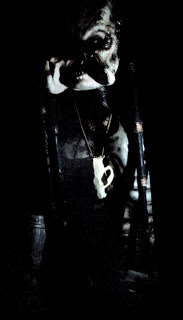 Much has been made by horror writers, filmmakers, and critics about the attractiveness of the horror genre. Countless tomes, articles, blogs, and essays have been written on the subject. I even grappled with it a bit in my review of Noel Carroll's
The Philosophy of Horror
(an excellent work), and wrapped up my thoughts here. You could also Google "Why do people like horror?", and get literally hundreds of results.
Much has been made by horror writers, filmmakers, and critics about the attractiveness of the horror genre. Countless tomes, articles, blogs, and essays have been written on the subject. I even grappled with it a bit in my review of Noel Carroll's
The Philosophy of Horror
(an excellent work), and wrapped up my thoughts here. You could also Google "Why do people like horror?", and get literally hundreds of results. So I'm not going to rehash that all here.
Instead, I'm going to share an experience from my vacation, in which I actually FELT fear, and it made me feel better, afterward.
Now, I'm a pretty boring guy (I think so, anyway). I'd rather read and write most of the time, but I also like spending time with my wife or friends, playing with the kids, or simply mowing and raking the lawn or puttering around in my garden. And, ironically enough, I've never been much of a horror movie fan.
So consequently, I don't go out of my way, usually, to seek that "fright" experience. Let's be honest, a scary novel - and it's debatable how many novels can actually SCARE us - can always be put down. A horror movie on TV or DVD can be paused or stopped. Even a horror movie in the theater can be walked out on. These are reasons why Noel Carroll, in his work The Philosophy of Horror doesn't totally "buy" the catharsis of simulated fear for these experiences, because we can always "tap out", so to speak, if it gets too scary.
This past week, however, I willingly engaged in an experience that, once in the middle of, was much harder to quit than all the above circumstances. And, believe it or not, it was actually enough to make the heart beat faster, make me breath a little heavier, and experience some really unsettling, fear-like symptoms.
It was a "spooky" wax museum. The "House of Frankenstein Wax Museum", in Lake George, as a matter of fact.
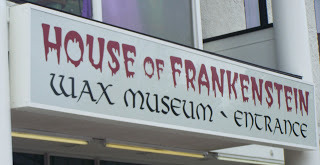
I tried to get Madi or Zack to go in with me - on the ticket taker's assurance that the museum featured no moving parts, just still life - but they wouldn't bite. So, Abby told me to go ahead for myself. I felt a little silly - a little selfish, going on a joyride by myself - but several turns into the tour, I felt a lot less silly.
And just a little bit...disconcerted. Uneasy. Dare I say...afraid?
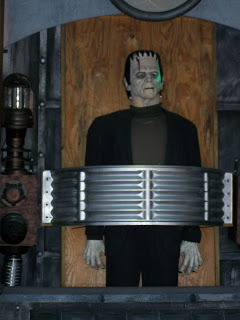 I'll say this, the folks at the House of Frankenstein did a nice job, especially with a bunch of largely inanimate wax statues. The lighting was perfect, JUST light enough for me to see "something", lots of blind corners, and several spots brightly lit that "faked me out", made me think the tour was over, even though it'd just begun.
I'll say this, the folks at the House of Frankenstein did a nice job, especially with a bunch of largely inanimate wax statues. The lighting was perfect, JUST light enough for me to see "something", lots of blind corners, and several spots brightly lit that "faked me out", made me think the tour was over, even though it'd just begun.I'd round a corner, completely shrouded in darkness...and then a display would light up. I'd descend a flight of brightly lit, normal looking stairs, expecting it to be over...turn the corner, and once more find things shrouded in darkness.
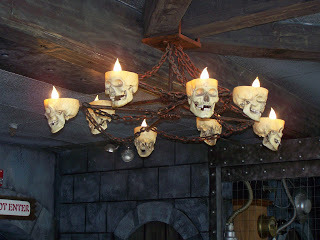
The most startling experience was probably the most cliche. I turned a corner and stood at an entrance labeled "Tourist Trap." Now, of course, I'm thinking to myself, "Yeah, right. How lame." Of course, that's what I was thinking on the surface. Being all brave and jaded and grown-up, and all. On the inside, however?
I'm thinking: Oh, crap. I'M a tourist. This was made for ME.
So I walked into the darkness. Felt the walls change to chain-link fences. About halfway through, lights started flashing, plastic started rustling...and I saw them.
The bodies.
Shrouded in clear plastic bags, dressed in tourist clothes of all kinds...hanging by their feet from the ceiling. Dozens of them.
Of course, all wax figures.
But still pretty effective. And even worse than the museum itself was an interesting....hiccup. Fodder for a future story, certainly. See, a father and his reluctant teenage daughter went before me, after much coaxing from the ticket taker. And somehow, in the first fifteen minutes of the tour, they must've double-backed on me...or something...
Because they disappeared.
And all I could think for the rest of the tour was: Where did they GO!?!
Even the attendant at the end with the walky-talky wasn't quite sure where they went.
Hmmmmm.
And you can bet, when that tour was done....WOW. Sounds really corny, but the sun shined just a little bit brighter, the air felt warmer, and I was REALLY happy to catch up with the rest of the family. Literally happy to be alive.
Anyway, though I know it's a holiday and probably a poor day for garnering blog responses... What about you? Any of you out there experience anything like this? A fear-experience - willing undertaken - that made you feel more alive afterwards?
Published on July 04, 2012 05:38
July 2, 2012
On Being the English Teacher I Am
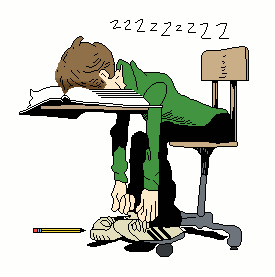 So, the school year is two weeks over. Another year done. I had some ideas about blogging the last day in school, but I got busy, then went on vacation, so here I am with the first summer post, looking back on this past school year.
So, the school year is two weeks over. Another year done. I had some ideas about blogging the last day in school, but I got busy, then went on vacation, so here I am with the first summer post, looking back on this past school year.It was probably one of the best I can remember. As for End of the Year evaluations and such, I got the usual: "An Effective Teacher". Essentially, a 3 out of a 4 point scale. And I'm cool with that. After eleven years teaching, nearly fifteen total working in school systems of some kind, I've become very pragmatic about evaluations. Basically, if I'm offered a job the following year, not deemed a lost-cause, I'm a pretty happy camper.
It also helps that, at this stage in my career, I pretty much always agree with my administrator's critiques, and look at the evaluation as feedback that will only improve my teaching. However, something felt different this year. For the first time, I didn't feel...desperate for it to end.
Don't get me wrong. Was definitely looking forward to summer. Had/Have some huge reading and writing plans, so I'm glad it's here, loving every minute of it. But this was the first year I can remember NOT ravening for school to end. The year ran smoothly. I feel my classes DID something. And I was still busy with them, right up until the end.
It helped that I had some good kids to work with. But, most importantly, I feel like I hit a milestone: I achieved some balance between what I believe are important works that all students should read, and books that I simply LOVE, and had a feeling a lot of them would love, too.
Teaching high school English is a funny thing, especially when it comes to assigning literature. Though I always have ONE ringer (a book that, historically, 90 percent of the students will like), I never get all the students to like all the books I teach. It's impossible.
For example, every year, my freshman are split on Something Wicked This Way Comes and Fahrenheit 451, by Ray Bradbury. Those who loved SWTWC generally dislike F451, and those who liked F451 dislike SWTWC. Interesting where those lines fall.
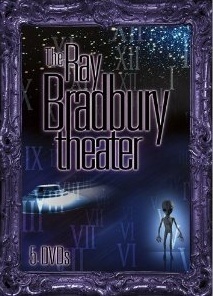 What really seems important to me about this year is I seemed to hit on some things the kids really enjoyed, especially my freshman. Introducing The Ray Bradbury Theater at the end of the year - HBO adaptations of fifty or so Bradbury shorts - was a masterstroke. Using The Twilight Zone in Creative Writing also paid big dividends. Though I'm unsure as to whether I'll use it next year, I'd have to say Buffy the Vampire Slayer really worked well with my 10th Grade Honors English class.
What really seems important to me about this year is I seemed to hit on some things the kids really enjoyed, especially my freshman. Introducing The Ray Bradbury Theater at the end of the year - HBO adaptations of fifty or so Bradbury shorts - was a masterstroke. Using The Twilight Zone in Creative Writing also paid big dividends. Though I'm unsure as to whether I'll use it next year, I'd have to say Buffy the Vampire Slayer really worked well with my 10th Grade Honors English class.I guess what's mostly different about how this year ended is this: I actually felt like an English teacher. After 11 years, I actually felt like I kinda maybe sorta deserve the title. This is not me being overly humble. I arrived at teaching English through a very winding route. I initially set out to get my BA in English/Literature, with an eye towards an MA, to teach college English/Literature.
I got the BA, took the dreaded "break" - and life invaded. Before I knew it, I was married, with a house and bills, and after a year off, was teaching junior high English. And even though I'm wrapping up my MA in English/Creative Writing...I've never taken any Education classes.
No Pedagogy.
No "Instructional Strategies" classes.
Sure, I've been to lots of seminars and conferences. But, according to New York State, I'm not a "certified teacher" eligible to teach in the public schools.
Don't get me wrong. I'm not slamming teacher certification. It's important. During the time I've spent teaching in the private sector, I've seen plenty of "teachers" who don't deserve the title, who probably would've been vetted through the certification process. In fact, that's probably why they never took that route in the first place.
However, on the flip side, I've encountered lots of folks with certification who couldn't teach to save their lives. So I've always maintained the philosophy that being a TEACHER was something that resided deep inside, in your soul. It's one of the things HE stamped on your forehead. Though it can help any teacher, all the Education and Pedagogy classes in the world will not make someone who is NOT a teacher a teacher.
Thing is, I never really believed that about myself (still kinda don't). I've always breathed a huge sigh of relief after signing a contract for the new year, thinking: "Wow. Thank GOODNESS no none found me out." So I've always felt a little bit like a faker, lucky to be teaching in the first place.
I certainly don't think I'm the best teacher ever, now. But I received a comment from a parent near the year's end that really touched upon what I think is the only thing I do well. They said, in effect:
"...he loves what he's doing, and he loves literature, and the kids see that."
And that's it. That's really the best thing I've got going. No fancy projects or innovative, interactive learning strategies. No awards, no groundbreaking success in teaching folks to read or write. I essentially teaching seminar-style (hard to do with freshman, but somehow I make it fly), and my approach to each class is very simplistic.
I just love books. And reading. Poetry. Short stories. I love them, I read all the time, and I do my best to bring that love to the classroom.
Probably the best description of how I feel comes from a Charles Grant short story, "Confess the Seasons", out of the recent PS Publishing collection, Scream Quietly: The Best of Charles Grant . It's about an English teacher (of course) reminiscing about why his relative success:
"Neither did I believe the ensuing acclaim all that richly deserved. All I'd done was fumble through my courses until I'd developed a primary and secondary school curriculum whose sole purpose was to avoid killing literature before students reached college, or the age of illiterate consent. Those who used it swore by it, and admittedly, it was successful....my secret, which was simple in the extreme - I loved reading."
This pretty much sums up my teaching method. I fumble through, honestly. The best thing I can do is somehow coax students to think about what they read without killing literature, coax them to at least appreciate the words on the page and their power, and to keep reading, and to keep loving it. And that last part is really the only thing I can control.
And here it is, summer vacation, and I'm thinking about instituting a "short story" day once a week for my freshman, in which I read aloud to them a short story...just because. Here it is, summer vacation...and I'm thinking about what I'm going to do next year in class.
It's almost like I'm a teacher, or something....
Published on July 02, 2012 05:35
June 23, 2012
On Being In Horror Library, Volume Five With Bentley Little, and Trying My Podcast Legs
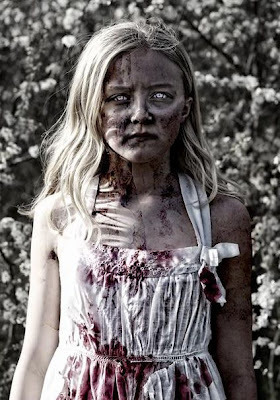 Great news I've been sitting on for awhile: my short story "Almost Home" will be published in Cutting Block Press' Horror Library, Volume 5, later this summer. Editor RJ Cavender is announcing each story in turn, and he announced mine second: right after Bentley Little's short story, "Notes for an Article on Bainbridge Farm."
Great news I've been sitting on for awhile: my short story "Almost Home" will be published in Cutting Block Press' Horror Library, Volume 5, later this summer. Editor RJ Cavender is announcing each story in turn, and he announced mine second: right after Bentley Little's short story, "Notes for an Article on Bainbridge Farm."Yeah, I know. Bentley Little, right? The guy Stephen King once called the "poet laureate" of horror. Him and I in the same TOC. Pretty awesome. And the cover is pretty creepy, also.
This hits other milestones, though. A significant one: this story's original form was battered around by the good folks at Borderlands Press Writers' Bootcamp. Speculative fiction writers, you'd do well to attend this writers conference someday. It will change your writing forever.
Also, this is one of the few short stories I've managed to write over the past few years that was internally generated. In other words, I wasn't writing a themed-story for a themed-anthology. Sure, it's speculative/horror/strange....but it pulls at something deeper. Came from somewhere inside me. I wrote it because of something in me, not because of a themed anthology I was trying to get into.
Which means, even this long after writing it: I still like this story. A lot. It comes closest of everything I've written to reflecting me. Something eerie, haunting, emotional, but spiritual and speculative, born of something very human. I hope to write more of these.
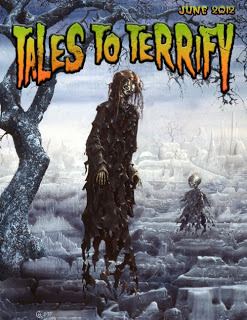 Also, this weekend my new podcast series, Horror 101, premiers at
Tales to Terrify
. My meager goal: to trace the horror genre's history from its beginnings in Gothic fiction to what it is today. I hope it to be informative, but also to keep the tone light, have some fun.
Also, this weekend my new podcast series, Horror 101, premiers at
Tales to Terrify
. My meager goal: to trace the horror genre's history from its beginnings in Gothic fiction to what it is today. I hope it to be informative, but also to keep the tone light, have some fun.An important note: I'm by no means an expert. I'll be traveling this road myself, learning as I go. Hopefully, we can all learn something together. Of course, the ultimate question is...why ?
In his examination of the horror genre, Danse Macabre, Stephen King says something like this:
"It's a matter of roots. It may not do any good to know that your grandfather liked to sit on the stoop of his building with his sleeves rolled up and smoke a pipe after supper, but it may help to know that he emigrated from Poland in 1888, that he came to New York and helped to build the subway system. If it does nothing else, it may give you a new perspective on your own morning subway ride...."
So that's what it's all about. I make no claims that this podcast will make anyone a better horror writer, or that being well-versed in horror's rich literary tradition will inherently make a better horror writer. But, it may very well offer us all a new perspective on the ride that is the horror story....
Anyway, check out the podcast, let me know what you think. I cue in around 23 minutes. And this is my first podcast, so be gentle...
Published on June 23, 2012 04:03
June 6, 2012
On Ray Bradbury......What Else Can I Say?
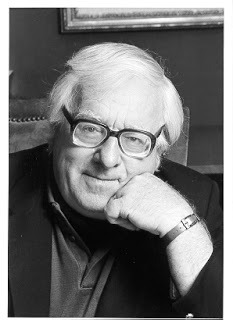 Los Angeles (CNN) -- Science fiction author Ray Bradbury, whose imagination yielded classic books such as "Fahrenheit 451," "The Martian Chronicles" and "Something Wicked This Way Comes," has died at 91, his publisher said Wednesday.
Los Angeles (CNN) -- Science fiction author Ray Bradbury, whose imagination yielded classic books such as "Fahrenheit 451," "The Martian Chronicles" and "Something Wicked This Way Comes," has died at 91, his publisher said Wednesday.Bradbury "died peacefully, last night, in Los Angeles, after a lengthy illness," HarperCollins said in a written statement. (Full Article)
I of course read Ray Bradbury in high school. Unfortunately, my teachers presented some of his short stories in a very backhanded way (let's be honest, my high school English teachers weren't the greatest), and I'd never read any of his novels until recently.
About six years ago, I fell in love all over again for the first time when, on a whim, I read Something Wicked This Way Comes and then Fahrenheit 451. I was struck by the absolute beauty and poetry in Something Wicked and of course, F451 spoke to my heart, not only timeless, but eerily prophetic.
After that, of course, came Dandelion Wine, The October Country, The Halloween Tree, and so many others. In a way, I felt like Douglas Spaulding in the beginning of Dandelion Wine, coming from this place of ignorance to awareness, coming ALIVE. Very similar to my reaction in discovering the late Charles L. Grant, I thought to myself: "MY GOD! How did I ever read before this?"
Because of this, I've been on a quest to infect as many students as I can with Bradbury-fever. I teach Something Wicked, F451, Dandelion Wine every year, and I recently started watching The Bradbury Theater - a collection of his short stories brought to life on the small screen - with my freshman. Admittedly, some don't catch this fever...but some do, and that does my heart glad.
And, ironically enough, I recently made plans - a commitment - to read a Bradbury short story every day this summer, soon as classes are over. My goal - to work through The Martian Chronicles, The Illustrated Man, and Golden Apples of the Sun by the end of the summer.
Just like so many readers and writers, I can't even BEGIN to describe the impact he's made on me. I can honestly say, the biggest thing I've always loved about him was the idealism in his works, because to me - he's the perfect definition of it. Many of his stories are sad and creepy and just odd...some downright chilling...but he wrote them all against a tapestry that believed in something BIGGER. I've never really explored his religious beliefs, but I definitely think it was in something BIGGER.
Then, of course, there's the beauty in his prose. The FEELING in every single line. I've always said, and stand by it: if I ever return to college and get my PHD, I'll do my dissertation on Ray Bradbury. That, and I've also recently tried to put into practice his recommendation for a writer's daily diet: a poem, short story, and an essay every day. I've just begun this daily diet, and already it seems like my head is bursting at the seams.
Anyway, I've got a post coming up about idealism and horror, so I'll save the rest of what I have to say for then. For now - a great writer has left us. He's often been described as a modern Samuel Clemens, and I don't think that's far off the mark. Anyway, I leave you with my favorite little YouTube clip of him, one I use with my students a lot. God Speed, Ray.
G
Published on June 06, 2012 10:29
June 3, 2012
On How My Head is So Full of Voices; I'm Still Trying to Find My Own
This is kind of a "place-holder" blog - I've had quite a few blogs simmering, on horror and post-modern horror and idealism and being an idealistic horror writer (not only idealistic about my career, but idealism IN my horror, if that makes any sense) - but for some reason, those blogs have swirled and simmered but not really coalesced.
Of course, it's the end of the school year, massive grading and finals are due, plus I've actually been solicited to write a short story - my very first - so besides my ongoing posts over at The Midnight Diner and my reviews - I've not been blogging, much. But I like to try and keep this space active, so I thought I'd post some musings about all the different types of stuff I read, stocking all these voices in my head, in hopes of finding my own.
One of the very first things fledgling writers do, I think, is try to imitate their favorite writers. I've been through that stage. Actually, been through several stages. My very early, unpublished stuff - so folks have told me - sounded very Stephen King-ish. So that was my Stephen King Phase. I also went through a Ray Bradbury Phase, then an H. P. Lovecraft Phase. My Peter Straub Phase ended in an unfinished, 600 page manuscript that I may or may not revisit.
The closest thing to something in my voice would be my novella, Hiram Grange & The Chosen One . I think. Maybe. At the very least, I was trying to say things my own way, without consciously copying someone.
I probably should worry less about it. Should spend more time writing, less time reading and absorbing so many different voices at once. The thing is - and maybe this is a conceit - I desperately want my voice to be MEMORABLE. I've read so many books and short stories that made no impact, stories and voices that I'll never read again. And then SOME of them were so powerful, so enduring, I keep coming back to them, over and over.
Anyway, I'm reading a lot right now. Very different stuff. And I have some serious (perhaps ludicrous) reading plans for the summer ahead. Now, I just love reading. I read fast, and I basically consume books. So this plan works well for me on a very selfish level. But I guess I'm also trying to absorb as many styles and voices and stories as possible.
See, I don't think I've found my voice yet. Most my stories are adequate. Competent. Hiram Grange was certainly fun and fast-paced. But I'm not sure if I've ever written something that's MINE.
Mort Castle once told me: "The real stuff, the stuff that lasts, comes out late-night conversations with your very own self."
Well, I've been doing two things, lately. LISTENING very deeply to those late night conversations (I've always had them), and reading as much stuff as possible. Here's my current reading list (always changing), what's on the plate right now:
Every morning, before and during breakfast:
King James Bible - Book of Ephesians
A chapter from Miracles, by C. S. Lewis
Undead: Night of the Living Dead, Return of the Living Dead, (Cemetery Dance) by John Russo
One Robert Frost poem
Before writing, morning and night:
A short story from Winesburg, Ohio, by Sherwood Anderson
Whenever I have a free moment at home (or, whenever 10 minutes comes and I'm doing nothing):
Danse Macabre, by Stephen King
First Period Planning at school:
Faces in the Fire, by T. L. Hines (teaching to 10th Grade Honors)
Every night before bed:
Scream Quietly: The Best of Charles L. Grant
One William Blake poem
Now, the summer ahead, I've got some ludicrous plans. Of course, as a teacher, I have the summer off. And as an English teacher, I tell myself this is an important part of my JOB, after all. To read all the time, keep my mind sharp and nimble. In addition to books I'll be reviewing and books for just plain fun, here's my agenda this summer, in no particular order:
A Ray Bradbury short story every day, from my omnibus containing The Martian Chronicles, The Illustrated Man, and Golden Apples of the Sun
Grapes of Wrath, by John Steinbeck
House on Haunted Hill, by Shirley Jackson
House of Seven Gables, by Nathanial Hawthorne
The Man Who Was Thursday, by G. K. Chesterton
More Manly Wade Wellman
An exploration of the first Gothic Fiction novels
Supernatural Horror in Literature, by H. P. Lovecraft
I know. Crazy. And this doesn't even count random books just "because", or the books I'll be reviewing. But you know what? The sad - or fortunate - thing is, I'd rather be reading, honestly, than most anything else (except being with my family - wife and kids - working outside in the garden, and of course, writing). Even when I'm at Cons, most of the time, you can find me holed up in a corner, reading. Sadly, I think I'd rather read than talk to people, sometimes....
So what voices are in your head, at the moment?
Of course, it's the end of the school year, massive grading and finals are due, plus I've actually been solicited to write a short story - my very first - so besides my ongoing posts over at The Midnight Diner and my reviews - I've not been blogging, much. But I like to try and keep this space active, so I thought I'd post some musings about all the different types of stuff I read, stocking all these voices in my head, in hopes of finding my own.
One of the very first things fledgling writers do, I think, is try to imitate their favorite writers. I've been through that stage. Actually, been through several stages. My very early, unpublished stuff - so folks have told me - sounded very Stephen King-ish. So that was my Stephen King Phase. I also went through a Ray Bradbury Phase, then an H. P. Lovecraft Phase. My Peter Straub Phase ended in an unfinished, 600 page manuscript that I may or may not revisit.
The closest thing to something in my voice would be my novella, Hiram Grange & The Chosen One . I think. Maybe. At the very least, I was trying to say things my own way, without consciously copying someone.
I probably should worry less about it. Should spend more time writing, less time reading and absorbing so many different voices at once. The thing is - and maybe this is a conceit - I desperately want my voice to be MEMORABLE. I've read so many books and short stories that made no impact, stories and voices that I'll never read again. And then SOME of them were so powerful, so enduring, I keep coming back to them, over and over.
Anyway, I'm reading a lot right now. Very different stuff. And I have some serious (perhaps ludicrous) reading plans for the summer ahead. Now, I just love reading. I read fast, and I basically consume books. So this plan works well for me on a very selfish level. But I guess I'm also trying to absorb as many styles and voices and stories as possible.
See, I don't think I've found my voice yet. Most my stories are adequate. Competent. Hiram Grange was certainly fun and fast-paced. But I'm not sure if I've ever written something that's MINE.
Mort Castle once told me: "The real stuff, the stuff that lasts, comes out late-night conversations with your very own self."
Well, I've been doing two things, lately. LISTENING very deeply to those late night conversations (I've always had them), and reading as much stuff as possible. Here's my current reading list (always changing), what's on the plate right now:
Every morning, before and during breakfast:
King James Bible - Book of Ephesians
A chapter from Miracles, by C. S. Lewis
Undead: Night of the Living Dead, Return of the Living Dead, (Cemetery Dance) by John Russo
One Robert Frost poem
Before writing, morning and night:
A short story from Winesburg, Ohio, by Sherwood Anderson
Whenever I have a free moment at home (or, whenever 10 minutes comes and I'm doing nothing):
Danse Macabre, by Stephen King
First Period Planning at school:
Faces in the Fire, by T. L. Hines (teaching to 10th Grade Honors)
Every night before bed:
Scream Quietly: The Best of Charles L. Grant
One William Blake poem
Now, the summer ahead, I've got some ludicrous plans. Of course, as a teacher, I have the summer off. And as an English teacher, I tell myself this is an important part of my JOB, after all. To read all the time, keep my mind sharp and nimble. In addition to books I'll be reviewing and books for just plain fun, here's my agenda this summer, in no particular order:
A Ray Bradbury short story every day, from my omnibus containing The Martian Chronicles, The Illustrated Man, and Golden Apples of the Sun
Grapes of Wrath, by John Steinbeck
House on Haunted Hill, by Shirley Jackson
House of Seven Gables, by Nathanial Hawthorne
The Man Who Was Thursday, by G. K. Chesterton
More Manly Wade Wellman
An exploration of the first Gothic Fiction novels
Supernatural Horror in Literature, by H. P. Lovecraft
I know. Crazy. And this doesn't even count random books just "because", or the books I'll be reviewing. But you know what? The sad - or fortunate - thing is, I'd rather be reading, honestly, than most anything else (except being with my family - wife and kids - working outside in the garden, and of course, writing). Even when I'm at Cons, most of the time, you can find me holed up in a corner, reading. Sadly, I think I'd rather read than talk to people, sometimes....
So what voices are in your head, at the moment?
Published on June 03, 2012 10:23
May 23, 2012
On Breaking Your Kids' Things (But Hopefully Not Their Hearts)
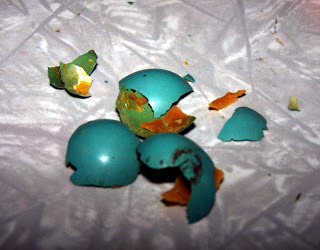 I sometimes forget how much our kids rely on us as parents, and not just for the basics: food, clothing, shelter, protection, etc. They rely on us to be Mom and Dad. Mom comforts and assures and gives hugs and kisses and makes them feel better when they're sick, Dad explains how things work, scares the bullies away, fixes things, and makes things work again.
I sometimes forget how much our kids rely on us as parents, and not just for the basics: food, clothing, shelter, protection, etc. They rely on us to be Mom and Dad. Mom comforts and assures and gives hugs and kisses and makes them feel better when they're sick, Dad explains how things work, scares the bullies away, fixes things, and makes things work again.We're not supposed to break things, are we? Because - especially at this age - Mom and Dad are perfect. We supply everything they need, are the ones they immediately look to (in an ideal situation, and of course, not every situation is ideal) for answers. And most of the time, even when the questions get a little more complicated - where do babies come from, why do people die, where's God live and did He make dinosaurs and people? - we have the answers. We take care of stuff.
We fix things.
And in the hustle and bustle of everyday life, we take for granted how much of a bedrock assurance this is for our kids. We take for granted what a prized position we hold - or, can and should hold - in our kids' eyes.
So breaking things comes as a sobering reminder that we're not perfect (who is?), that we face the inevitable occurrence of someday letting our children down, hurting them or disappointing them.
This terrifies me, personally. I'm okay with disciplining my kids and them being unhappy with me because of this, or them not "liking me" (kind of planning on that teenage stage ahead of time, actually), because an important part of parenting is sticking to your guns, doing what's right - not what they want - and bracing for that inevitable teenage angst that's sure to come when they don't get their way.
But letting them down.
Making a mistake, give them a glaring example of how we're not perfect, and how sometimes we break things....
That hurts.
Yesterday, Madi wanted to take a blue bird egg - one of her prized possessions - into school for Show and Tell. Abby had gone to work, so Madi and I were brainstorming ways to get the egg into school in one piece. I thought putting it in an empty vitamin container would be a good idea. And it might've been, if I'd also stuffed it with cotton, or something.
I hadn't.
So, while trying to write in Sharpie on the bottle's side "Bluebird Egg", I fumbled the darn thing. Dropped it.
And my heart sank at Madi's soft, whispery little, "Oh, no."
I picked it up, and knew instantly by the sounds inside that her bluebird egg had shattered. Felt even worse when she said, just as softly, "That's the only one I have."
There were no tears. I actually would've felt better if there had been. At age 7, Madi is already extremely talented at hiding her feelings. Whenever she's upset about something personally, a blank look crosses her face, her voice gets soft and quiet...but then she covers right over it, and acts like everything is normal. On one hand, at least it's good she's learned how to deal with her emotions so young. On the other hand, I worry she represses too much when she should express her feelings, but that's another worry for another time.
Anyway, I felt devastated. I was able to redirect Madi to something else for Show and Tell - an old feather she'd found out back (she's a collector of oddities and baubles, just as her Daddy is), and apparently her classmates were sufficiently "wowed" by that, theorizing that it was a bald eagle feather, or a Japanese Eagle feather.
But I felt bummed for the whole day. I'm Dad, after all. I'm the guy who's supposed to fix things, right? Not fumble and break them. It's a haunting premonition, because it makes me wonder what other things down the road I'm going to fumble and 'break'. What ways I'm going to let both my kids down and hurt them. And wonder, if maybe I'll ever break something so bad, a big hug and a profuse apology won't be enough to fix it.
Probably a little overkill, but I'm keeping those bluebird egg shards in that bottle. I don't want to forget how easy it is to fumble and break stuff, when I'm supposed to fix stuff. And I know it's going to happen, someday. Hard to avoid. And I know that, even then, probably all I'll be able to offer is a huge hug and my profound apology.
But hopefully, that'll be enough. And maybe, I'll be teaching them something, too. That we make mistakes and hurt others. And when we do, we always face up, and ask for their forgiveness. And maybe, that won't fix everything they face in the future.
But sometimes, there's nothing else you can do.
Published on May 23, 2012 03:40
May 18, 2012
For Your Consideration; My Paper On Postmodern Horror Cinema
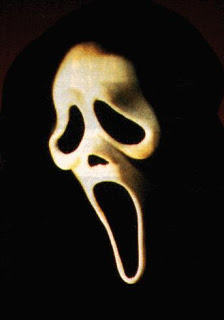 So, that's it and that's all. My paper - "An Examination of Postmodern Horror Cinema" - has been emailed in. For now, at least - hopefully, or a very long time - I am done with graduate school.
So, that's it and that's all. My paper - "An Examination of Postmodern Horror Cinema" - has been emailed in. For now, at least - hopefully, or a very long time - I am done with graduate school.And I've decided to post my paper here, for anyone interested. During the writing of this, I'd actually entertained thoughts of trying to publish it somewhere. Eventually, however, I decided against it, for the following reasons -
If I'm a relative nobody in the world of horror fiction, I'm an ABSOLUTE nobody in the world of horror cinema. I chose this topic because it was a great opportunity to write about something that interests me. But, as I've admitted several times on my blog, I'm no horror movie aficionado.
So, while I now feel like a I know a whole lot more about horror cinema and postmodernism and postmodern horror cinema than I knew before, I'm in no way an authority on the matter. This essay was more of an exercise in exploration and discovery. WAY more people out there far more experienced than I am in horror cinema, so I could never pretend I'm in any way, any type of authority.
Also - because this was more me trying to understand postmodernism and postmodern horror cinema better - this paper is a bit derivative. Yeah, I advance a few ideas and opinions of my own, but it's not like I'm making a grand statement about horror cinema no one else has ever made before. So it doesn't seem to make much sense, trying to get it published somewhere. Of course, if anyone is ever interested in a re-tooled, shortened version, I wouldn't hesitate. But I'm not going to submit this anywhere, fooling myself I'm saying anything worthwhile or "new".
So, since I'm not concerned about copyright, I offer it here to you. To read and share at your leisure. Just click the following Google Docs Link:
An Examination of Postmodern Horror Cinema
...and it's yours. You can print it off, share, and don't need to be logged into Google to do so. Also, if you click 'Print' and then cancel 'Print', it zooms the PDF document full screen in your browser. You can also go to the upper right, click 'File' and 'Download.'
And again, please - I'm no authority in this area. I simply wrote this paper because I wanted to understand Postmodernism and postmodern horror cinema better. And, even though it's been read and re-read, my brain is mush, and there are very likely errors here and there.
So excuse me while I go collapse in a fit of exhaustion....
Published on May 18, 2012 02:14
May 17, 2012
"How Horror Cinema Offers Effective Meditation On Issues Which Affect Society" - Buffy the Vampire Slayer and Horror Movies
Nearing the end of this paper, so hopefully tomorrow will see an original blog. Here again, however, for your interest or for simply kicks, part of my closing statements in my paper for Film & Philosophy: (WARNING! NOT EDITED!)
In Isabel Pinedo’s assessment, horror is an “exercise in recreational terror”, a simulation of danger not unlike a roller coaster ride – something that provides thrills and chills, but is essentially “safe” (25). Horror also denaturalizes the “repressed” (fears, worries, anxieties), by transmuting the “natural” elements of everyday life into the unnatural form of the “monster” (26).
In other words, the things we fear in life - loss, loneliness, failure, death, betrayal, loss of self, marginalization, age – are often (but not always) transformed into monsters in the horror film, making them more emotionally accessible. And, up for potential “defeat”. So by “monstrifying” these fears, horror films unearth our repressed fears and worries to be dealt with in a unconscious manner we may merely recognize as “narrative pleasure”, IE. we “enjoy the story”.
Pinedo relates this to Freud’s dream theories, that as dreams displace and condense repressed thoughts and feelings, so horror films introduce monstrous elements to “disfigure” or diminish our own horrors. As dreams are unconscious attempts to express conflicts and resolve tensions, so horror films allow audiences to express and master feelings too threatening to articulate or face consciously.
So because of this, Pinedo believes that all horror films must strike a tenuous balance: they must produce a fear-experience that will not generate too much distress to make us walk out of the theater, but be thrilling enough for us to engage in this “fear-experience” (26). This, of course, varies depending on the film and director, as well as on individual film viewer’s varying constitutions and tastes.
Though not a movie but a television series, Buffy the Vampire Slayer serves as an excellent example of this method of “monstrifying fears”, especially in regards to teenage fears. First, and most basic: Sunnydale High School sits over a “Hellmouth”, which is a portal to hell, presenting an excellent image of what many students must think: ‘school is hell.’
Other struggles are “monstrified”: a possessive boyfriend literally transforms into an abusive “monster” after taking a home-made serum that amplifies his abilities, an overbearing mother desperate to relive her high school glory days uses magic to switch places with her daughter. Xander, one of Buffy’s friends, “falls in” with the “wrong crowd” and begins acting (and turning into) a hyena, preying upon the weak.
A boy beaten into a coma by his little league coach for missing a fly ball projects his astral self and fractures the time-space-continuum, bringing everyone’s nightmares – Buffy’s casual dismissal by her estranged father, Giles’ failure as a Watcher, resulting in Buffy’s death and resurrection as a vampire - to horrifying life. A homicidal cyborg tricks Buffy’s friends and even mother into accepting him into their lives, playing the role of a caring, loving man who just wants to make Buffy's single mother happy - who then begins to mistreat Buffy behind the scenes.
And finally, when Buffy and Angel consummate their love, he “transforms” into a monster, losing his soul, their very consummation destroying the love they once had, which most high school partners never consider, that sex is a huge, cataclysmic event that alters us all: on a deep, fundamental level of the soul. Whatever else can be said about Buffy as a vehicle for post-modern horror or just as a television show in general, one thing it succeeded at was “monstrifying” the fears and struggles of teenagers into literal monsters within the show’s narrative.
Noel Carroll agrees with this proposed relationship between horror films and audiences, and offers a more nuanced expansion of Pinedo’s idea of “narrative pleasure” with his theory of General and Universal Theories of Horrific Appeal. According to Carroll, because many horror films are narrative-based stories bent on discovering unknown or unknowable things, he theorized that even as audiences are necessarily disquieted or distressed or even disgusted and repulsed by the revelation of these things, they are drawn to how these things unfold within the structure of the narrative.
Their desire to know draws them into these stories; they simply want to discover, to know, to see how it all ends. They are fascinated with the process of the investigation, exploration, discovery, and then - if possible – the overcoming of unknowable, impossible things (189 – 191), even if, in the postmodern sense, most of these monsters can’t be overcome. Audiences still want to see people try.
These are very broad ways that horror in general can provide “effective meditation on issues which affect society.”
And here's hoping I'll be done soon....
** quotations taken from Isabel Pinedo's essay "Recreational Terror: Postmodern Elements of the Contemporary Film" and Noel Carroll's The Philosophy of Horror.
In Isabel Pinedo’s assessment, horror is an “exercise in recreational terror”, a simulation of danger not unlike a roller coaster ride – something that provides thrills and chills, but is essentially “safe” (25). Horror also denaturalizes the “repressed” (fears, worries, anxieties), by transmuting the “natural” elements of everyday life into the unnatural form of the “monster” (26).
In other words, the things we fear in life - loss, loneliness, failure, death, betrayal, loss of self, marginalization, age – are often (but not always) transformed into monsters in the horror film, making them more emotionally accessible. And, up for potential “defeat”. So by “monstrifying” these fears, horror films unearth our repressed fears and worries to be dealt with in a unconscious manner we may merely recognize as “narrative pleasure”, IE. we “enjoy the story”.
Pinedo relates this to Freud’s dream theories, that as dreams displace and condense repressed thoughts and feelings, so horror films introduce monstrous elements to “disfigure” or diminish our own horrors. As dreams are unconscious attempts to express conflicts and resolve tensions, so horror films allow audiences to express and master feelings too threatening to articulate or face consciously.
So because of this, Pinedo believes that all horror films must strike a tenuous balance: they must produce a fear-experience that will not generate too much distress to make us walk out of the theater, but be thrilling enough for us to engage in this “fear-experience” (26). This, of course, varies depending on the film and director, as well as on individual film viewer’s varying constitutions and tastes.
Though not a movie but a television series, Buffy the Vampire Slayer serves as an excellent example of this method of “monstrifying fears”, especially in regards to teenage fears. First, and most basic: Sunnydale High School sits over a “Hellmouth”, which is a portal to hell, presenting an excellent image of what many students must think: ‘school is hell.’
Other struggles are “monstrified”: a possessive boyfriend literally transforms into an abusive “monster” after taking a home-made serum that amplifies his abilities, an overbearing mother desperate to relive her high school glory days uses magic to switch places with her daughter. Xander, one of Buffy’s friends, “falls in” with the “wrong crowd” and begins acting (and turning into) a hyena, preying upon the weak.
A boy beaten into a coma by his little league coach for missing a fly ball projects his astral self and fractures the time-space-continuum, bringing everyone’s nightmares – Buffy’s casual dismissal by her estranged father, Giles’ failure as a Watcher, resulting in Buffy’s death and resurrection as a vampire - to horrifying life. A homicidal cyborg tricks Buffy’s friends and even mother into accepting him into their lives, playing the role of a caring, loving man who just wants to make Buffy's single mother happy - who then begins to mistreat Buffy behind the scenes.
And finally, when Buffy and Angel consummate their love, he “transforms” into a monster, losing his soul, their very consummation destroying the love they once had, which most high school partners never consider, that sex is a huge, cataclysmic event that alters us all: on a deep, fundamental level of the soul. Whatever else can be said about Buffy as a vehicle for post-modern horror or just as a television show in general, one thing it succeeded at was “monstrifying” the fears and struggles of teenagers into literal monsters within the show’s narrative.
Noel Carroll agrees with this proposed relationship between horror films and audiences, and offers a more nuanced expansion of Pinedo’s idea of “narrative pleasure” with his theory of General and Universal Theories of Horrific Appeal. According to Carroll, because many horror films are narrative-based stories bent on discovering unknown or unknowable things, he theorized that even as audiences are necessarily disquieted or distressed or even disgusted and repulsed by the revelation of these things, they are drawn to how these things unfold within the structure of the narrative.
Their desire to know draws them into these stories; they simply want to discover, to know, to see how it all ends. They are fascinated with the process of the investigation, exploration, discovery, and then - if possible – the overcoming of unknowable, impossible things (189 – 191), even if, in the postmodern sense, most of these monsters can’t be overcome. Audiences still want to see people try.
These are very broad ways that horror in general can provide “effective meditation on issues which affect society.”
And here's hoping I'll be done soon....
** quotations taken from Isabel Pinedo's essay "Recreational Terror: Postmodern Elements of the Contemporary Film" and Noel Carroll's The Philosophy of Horror.
Published on May 17, 2012 03:07
May 15, 2012
My Roots of Classic and Post-Modern Fears
I've been keeping my head down this week, trying to finish my paper on post-modern horror for a Film & Philosophy graduate class. Hoping to blog about that eventually, summarizing my views on said topic, but until then, here's essentially my opening statements, reflecting on my earliest brushes with the horror genre....
*** As an adolescent and then later a teenager, I wasn’t a consistent fan of the horror genre. I mostly devoured science fiction novels and comic books and Saturday morning cartoons, though childhood staples such as these certainly possessed enough strains of horror DNA in their own right, even back then. But mostly, I was a Flash Gordon, Star Trek, Star Wars, Spider-Man & His Amazing Friends kind of kid. So memories of the few times I actually saw something that frightened me stand out vividly.
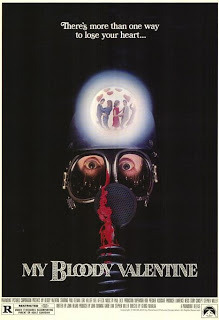 The earliest incident occurred in a movie theater lobby, when my father took the family to see Never Cry Wolf. The movie itself wasn’t scary. But in the lobby before the movie, while waiting in line, I saw a poster for My Bloody Valentine. My memories of the poster’s exact details are sketchy – a shadowy face in a blood-smeared gas mask – but I remember a very visceral reaction, deep inside. Something seemed wrong about that poster, that hidden face and those wide, crazed eyes.
The earliest incident occurred in a movie theater lobby, when my father took the family to see Never Cry Wolf. The movie itself wasn’t scary. But in the lobby before the movie, while waiting in line, I saw a poster for My Bloody Valentine. My memories of the poster’s exact details are sketchy – a shadowy face in a blood-smeared gas mask – but I remember a very visceral reaction, deep inside. Something seemed wrong about that poster, that hidden face and those wide, crazed eyes.
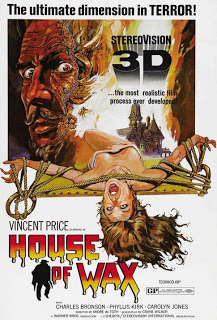 The second incident occurred a few years later around Christmas, visiting my Aunt and Uncle’s. Bored and ready to go home and flipping through the television channels, I came across Vincent Price’s House of Wax, circa 1953. Apparently, the adults must have been busy elsewhere, because I kept watching uninterrupted. And while the concept of being turned into a living wax dummy – unable to speak, talk, or move, dead and alive at once – was frightening enough, the scariest scene came when a female character (if I’m remembering the right movie) was impaled through the abdomen with a metal pipe, pinned to the wall. But that wasn’t the worst. The worst was watching blood slowly trickle out of the pipe’s end. Like she’d become nothing more than a bag of blood drained by a big metal straw. Like those weird “space milk” pouches they’d started serving with our school lunches.
The second incident occurred a few years later around Christmas, visiting my Aunt and Uncle’s. Bored and ready to go home and flipping through the television channels, I came across Vincent Price’s House of Wax, circa 1953. Apparently, the adults must have been busy elsewhere, because I kept watching uninterrupted. And while the concept of being turned into a living wax dummy – unable to speak, talk, or move, dead and alive at once – was frightening enough, the scariest scene came when a female character (if I’m remembering the right movie) was impaled through the abdomen with a metal pipe, pinned to the wall. But that wasn’t the worst. The worst was watching blood slowly trickle out of the pipe’s end. Like she’d become nothing more than a bag of blood drained by a big metal straw. Like those weird “space milk” pouches they’d started serving with our school lunches.
The third incident occurred many years later, when I was fifteen. One day in Art class, I went into the storeroom for supplies. There, I accidentally discovered my Art teacher’s old stash of EC Horror Comics. In one of them, I read a story about these two brothers, out in the woods. They came across a swamp or bog or something. One brother got stuck, sucked down by the mire. The other, a coward, left him there, fled home, and lied to his parents about his brother’s whereabouts, saying he didn’t know where he was.
Of course, it wasn’t long – after the dead brother was declared missing – that the cowardly brother heard slurping, mucky footsteps outside his window at night. Driven mad by guilt and fear, he eventually returned to that bog, and...well, I guess we all know how that story ends.
And it certainly left me disturbed. Filled with an unsettling disquiet. How could someone leave their brother to die like that? How horrible would it be carrying all that guilt...and think about the OTHER brother, the one now transformed into a walking mud-thing. He may’ve gotten his vengeance...but he was still dead. And made of mud, forever. Nothing good about that, at all.
Looking back on those three very different experiences, I can recognize in them now the seed of what the horror genre has tried to grow in readers (and by the 1930’s, viewers) for centuries. Fear. But not fear for mere sadistic, masochistic enjoyment. Not for ghoulish pleasure, or for the satisfaction of watching others suffer. But fear of things that violate our sense of what is right and natural. Fear of things that aren’t supposed to be.
And, even though my retrospective is certainly colored by hindsight, an ironic thing: how relieved I felt after leaving that movie theater and my Uncle and Aunt’s. Because in both cases, the safety of the family car, the familiar sounds of my parents’ conversation and music from their favorite light rock station reaffirmed my unconscious belief in things as they were meant to be. Even as I shivered a little, gazing into the dark night, normality had been restored, and I felt happy for it. And my happiness, I believe, had been intensified by the fear I’d felt only moments before. In a strange way, my fear had reaffirmed my belief in and desire for normality.
The emotional fear and eventual relief I felt in the first two incidents - my reactions to a movie poster and snippets from a movie playing on television - embody decently enough the function of a “classic” horror movie. Essentially, in classic horror movies, the narrative opens with the violent disruption of the normative order by a “monster". The monster could be almost anything, of course. Aliens, supernatural beings, mad scientists, even a deviant transformation from within a person. The rest of the story then revolves around the “monster” wrecking havoc, instilling terror in the hearts of the people (and the audience) and the people’s ineffectual attempts at defeating it. Eventually, either violence or knowledge is used to defeat the monster, restoring the normative order. In essence, the unnatural thing or “monster” is bested, and everything becomes as it once was – as it should be.
Also, the boundaries between “good” and “evil”, “normal” and “abnormal”, “human” and “alien” are clearly marked in classic horror movies. In the classic horror movie, threats to the existing social order are external, and eventually, human agency – or the forces of “good” - prevail. My perception of My Bloody Valentine’s movie poster was informed by this paradigm. A strange, inhuman thing leering at me with an almost tangible air of malevolence - I knew that was bad. When a little older and bit more sophisticated, I viewed the killer in House of Wax as clearly evil, killing innocent human beings (even though, in the fullness of the plot, the killer is seeking revenge for a crime perpetrated upon him).
My reaction to my third fear experience - the EC horror comic I discovered -was a little more nuanced. Because, really - who was “evil” in that story? One brother was certainly a selfish coward, abandoning his other brother to die in a swamp. And it could certainly be viewed as a morality play, the moral of the story being: “Don’t desert your loved ones, because they’ll come back and get you from beyond the grave.”
But his guilt and remorse for this cowardly act seemed to exempt him from being truly evil. And the swamp monster his brother became wasn’t exactly evil, either. Merely a sorrowful, vengeful wraith seeking vengeance. I came away from that story feeling uneasy, because I didn’t know where my sympathies should lie. With the wronged brother, now turned into a lurching, gurgling horror that would never find any peace? Or with the weaker brother whose worst crime was merely fear and indecision in a crisis?
This reaction more closely resembles what has become known as post-modern horror cinema. Very much like classic horror cinema, post-modern horror revolves around the violent introduction of a “monster” upon a normative state. People ineffectually try to defeat this monster. However, post-modern cinema differs from classic horror cinema in ways similar to my reaction to that EC horror comic.
Because throughout the post-modern horror movie’s narrative, lines of “good” and “evil” are blurred. Very quickly, characters – and by proxy, audiences – learn or at least suspect there’s no way to beat this monster. “Good” (or whatever is loosely defined as “good”) will not win in the end. Audiences are left perhaps feeling uneasy, unsettled because the narrative’s resolution doesn’t offer closure. The monster still lingers at the movie's end, ready to strike again....
*** And that's all for now. More later by the end of the week, hopefully. Thoughts?

*** As an adolescent and then later a teenager, I wasn’t a consistent fan of the horror genre. I mostly devoured science fiction novels and comic books and Saturday morning cartoons, though childhood staples such as these certainly possessed enough strains of horror DNA in their own right, even back then. But mostly, I was a Flash Gordon, Star Trek, Star Wars, Spider-Man & His Amazing Friends kind of kid. So memories of the few times I actually saw something that frightened me stand out vividly.
 The earliest incident occurred in a movie theater lobby, when my father took the family to see Never Cry Wolf. The movie itself wasn’t scary. But in the lobby before the movie, while waiting in line, I saw a poster for My Bloody Valentine. My memories of the poster’s exact details are sketchy – a shadowy face in a blood-smeared gas mask – but I remember a very visceral reaction, deep inside. Something seemed wrong about that poster, that hidden face and those wide, crazed eyes.
The earliest incident occurred in a movie theater lobby, when my father took the family to see Never Cry Wolf. The movie itself wasn’t scary. But in the lobby before the movie, while waiting in line, I saw a poster for My Bloody Valentine. My memories of the poster’s exact details are sketchy – a shadowy face in a blood-smeared gas mask – but I remember a very visceral reaction, deep inside. Something seemed wrong about that poster, that hidden face and those wide, crazed eyes. The second incident occurred a few years later around Christmas, visiting my Aunt and Uncle’s. Bored and ready to go home and flipping through the television channels, I came across Vincent Price’s House of Wax, circa 1953. Apparently, the adults must have been busy elsewhere, because I kept watching uninterrupted. And while the concept of being turned into a living wax dummy – unable to speak, talk, or move, dead and alive at once – was frightening enough, the scariest scene came when a female character (if I’m remembering the right movie) was impaled through the abdomen with a metal pipe, pinned to the wall. But that wasn’t the worst. The worst was watching blood slowly trickle out of the pipe’s end. Like she’d become nothing more than a bag of blood drained by a big metal straw. Like those weird “space milk” pouches they’d started serving with our school lunches.
The second incident occurred a few years later around Christmas, visiting my Aunt and Uncle’s. Bored and ready to go home and flipping through the television channels, I came across Vincent Price’s House of Wax, circa 1953. Apparently, the adults must have been busy elsewhere, because I kept watching uninterrupted. And while the concept of being turned into a living wax dummy – unable to speak, talk, or move, dead and alive at once – was frightening enough, the scariest scene came when a female character (if I’m remembering the right movie) was impaled through the abdomen with a metal pipe, pinned to the wall. But that wasn’t the worst. The worst was watching blood slowly trickle out of the pipe’s end. Like she’d become nothing more than a bag of blood drained by a big metal straw. Like those weird “space milk” pouches they’d started serving with our school lunches.The third incident occurred many years later, when I was fifteen. One day in Art class, I went into the storeroom for supplies. There, I accidentally discovered my Art teacher’s old stash of EC Horror Comics. In one of them, I read a story about these two brothers, out in the woods. They came across a swamp or bog or something. One brother got stuck, sucked down by the mire. The other, a coward, left him there, fled home, and lied to his parents about his brother’s whereabouts, saying he didn’t know where he was.
Of course, it wasn’t long – after the dead brother was declared missing – that the cowardly brother heard slurping, mucky footsteps outside his window at night. Driven mad by guilt and fear, he eventually returned to that bog, and...well, I guess we all know how that story ends.
And it certainly left me disturbed. Filled with an unsettling disquiet. How could someone leave their brother to die like that? How horrible would it be carrying all that guilt...and think about the OTHER brother, the one now transformed into a walking mud-thing. He may’ve gotten his vengeance...but he was still dead. And made of mud, forever. Nothing good about that, at all.
Looking back on those three very different experiences, I can recognize in them now the seed of what the horror genre has tried to grow in readers (and by the 1930’s, viewers) for centuries. Fear. But not fear for mere sadistic, masochistic enjoyment. Not for ghoulish pleasure, or for the satisfaction of watching others suffer. But fear of things that violate our sense of what is right and natural. Fear of things that aren’t supposed to be.
And, even though my retrospective is certainly colored by hindsight, an ironic thing: how relieved I felt after leaving that movie theater and my Uncle and Aunt’s. Because in both cases, the safety of the family car, the familiar sounds of my parents’ conversation and music from their favorite light rock station reaffirmed my unconscious belief in things as they were meant to be. Even as I shivered a little, gazing into the dark night, normality had been restored, and I felt happy for it. And my happiness, I believe, had been intensified by the fear I’d felt only moments before. In a strange way, my fear had reaffirmed my belief in and desire for normality.
The emotional fear and eventual relief I felt in the first two incidents - my reactions to a movie poster and snippets from a movie playing on television - embody decently enough the function of a “classic” horror movie. Essentially, in classic horror movies, the narrative opens with the violent disruption of the normative order by a “monster". The monster could be almost anything, of course. Aliens, supernatural beings, mad scientists, even a deviant transformation from within a person. The rest of the story then revolves around the “monster” wrecking havoc, instilling terror in the hearts of the people (and the audience) and the people’s ineffectual attempts at defeating it. Eventually, either violence or knowledge is used to defeat the monster, restoring the normative order. In essence, the unnatural thing or “monster” is bested, and everything becomes as it once was – as it should be.
Also, the boundaries between “good” and “evil”, “normal” and “abnormal”, “human” and “alien” are clearly marked in classic horror movies. In the classic horror movie, threats to the existing social order are external, and eventually, human agency – or the forces of “good” - prevail. My perception of My Bloody Valentine’s movie poster was informed by this paradigm. A strange, inhuman thing leering at me with an almost tangible air of malevolence - I knew that was bad. When a little older and bit more sophisticated, I viewed the killer in House of Wax as clearly evil, killing innocent human beings (even though, in the fullness of the plot, the killer is seeking revenge for a crime perpetrated upon him).
My reaction to my third fear experience - the EC horror comic I discovered -was a little more nuanced. Because, really - who was “evil” in that story? One brother was certainly a selfish coward, abandoning his other brother to die in a swamp. And it could certainly be viewed as a morality play, the moral of the story being: “Don’t desert your loved ones, because they’ll come back and get you from beyond the grave.”
But his guilt and remorse for this cowardly act seemed to exempt him from being truly evil. And the swamp monster his brother became wasn’t exactly evil, either. Merely a sorrowful, vengeful wraith seeking vengeance. I came away from that story feeling uneasy, because I didn’t know where my sympathies should lie. With the wronged brother, now turned into a lurching, gurgling horror that would never find any peace? Or with the weaker brother whose worst crime was merely fear and indecision in a crisis?
This reaction more closely resembles what has become known as post-modern horror cinema. Very much like classic horror cinema, post-modern horror revolves around the violent introduction of a “monster” upon a normative state. People ineffectually try to defeat this monster. However, post-modern cinema differs from classic horror cinema in ways similar to my reaction to that EC horror comic.
Because throughout the post-modern horror movie’s narrative, lines of “good” and “evil” are blurred. Very quickly, characters – and by proxy, audiences – learn or at least suspect there’s no way to beat this monster. “Good” (or whatever is loosely defined as “good”) will not win in the end. Audiences are left perhaps feeling uneasy, unsettled because the narrative’s resolution doesn’t offer closure. The monster still lingers at the movie's end, ready to strike again....
*** And that's all for now. More later by the end of the week, hopefully. Thoughts?
Published on May 15, 2012 04:17

